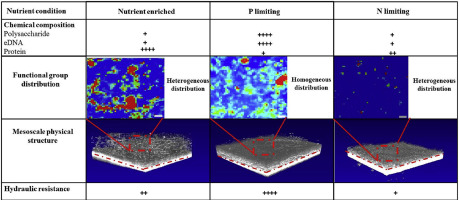Water Research ( IF 12.8 ) Pub Date : 2017-12-27 , DOI: 10.1016/j.watres.2017.12.058 Peter Desmond , James P. Best , Eberhard Morgenroth , Nicolas Derlon

|
The effect of extracellular polymeric substances (EPS) on the meso-scale physical structure and hydraulic resistance of membrane biofilms during gravity driven membrane (GDM) filtration was investigated. Biofilms were developed on the surface of ultrafiltration membranes during dead-end filtration at ultra-low pressure (70 mbar). Biofilm EPS composition (total protein, polysaccharide and eDNA) was manipulated by growing biofilms under contrasting nutrient conditions. Nutrient conditions consisted of (i) a nutrient enriched condition with a nutrient ratio of 100:30:10 (C: N: P), (ii) a phosphorus limitation (C: N: P ratio: 100:30:0), and (iii) a nitrogen limitation (C: N: P ratio: 100:0:10). The structure of the biofilm was characterised at meso-scale using Optical Coherence Tomography (OCT). Biofilm composition was analysed with respect to total organic carbon, total cellular mass and extracellular concentrations of proteins, polysaccharides, and eDNA. 2D-confocal Raman mapping was used to characterise the functional group composition and micro-scale distribution of the biofilms EPS. Our study reveals that the composition of the EPS matrix can determine the meso-scale physical structure of membrane biofilms and in turn its hydraulic resistance. Biofilms grown under P limiting conditions were characterised by dense and homogeneous physical structures with high concentrations of polysaccharides and eDNA. Biofilm grown under nutrient enriched or N limiting conditions were characterised by heterogeneous physical structures with lower concentrations of polysaccharides and eDNA. For P limiting biofilms, 2D-confocal Raman microscopy revealed a homogeneous spatial distribution of anionic functional groups in homogeneous biofilm structures with higher polysaccharide and eDNA concentrations. This study links EPS composition, physical structure and hydraulic resistance of membrane biofilms, with practical relevance for the hydraulic performances of GDM ultrafiltration.
中文翻译:

将细胞外聚合物(EPS)的组成与膜生物膜的物理结构和水力阻力联系起来
研究了细胞外聚合物质(EPS)对重力驱动膜(GDM)过滤过程中膜生物膜的介观物理结构和水力阻力的影响。在超低压(70 mbar)的死端过滤过程中,在超滤膜的表面上形成了生物膜。通过在相反的营养条件下生长生物膜来控制生物膜EPS组成(总蛋白,多糖和eDNA)。营养条件包括:(i)营养比为100:30:10(C:N:P)的营养丰富的条件,(ii)磷限量(C:N:P比例:100:30:0), (iii)氮限制(C:N:P比:100:0:10)。使用光学相干断层扫描(OCT)在中尺度上表征了生物膜的结构。针对总有机碳,总细胞质量和蛋白质,多糖和eDNA的细胞外浓度对生物膜组成进行了分析。使用二维共焦拉曼映射来表征生物膜EPS的官能团组成和微观分布。我们的研究表明,EPS基质的组成可以决定膜生物膜的介观物理结构,进而决定其水力阻力。在磷限制条件下生长的生物膜的特征是具有高浓度的多糖和eDNA的致密均匀的物理结构。在营养丰富或氮有限的条件下生长的生物膜的特征是异质物理结构,多糖和eDNA的浓度较低。对于限制磷的生物膜,二维共聚焦拉曼显微镜显示,在具有较高多糖和eDNA浓度的均质生物膜结构中,阴离子官能团的空间分布均匀。这项研究将膜生物膜的EPS组成,物理结构和水力阻力与GDM超滤的水力性能联系在一起。


























 京公网安备 11010802027423号
京公网安备 11010802027423号